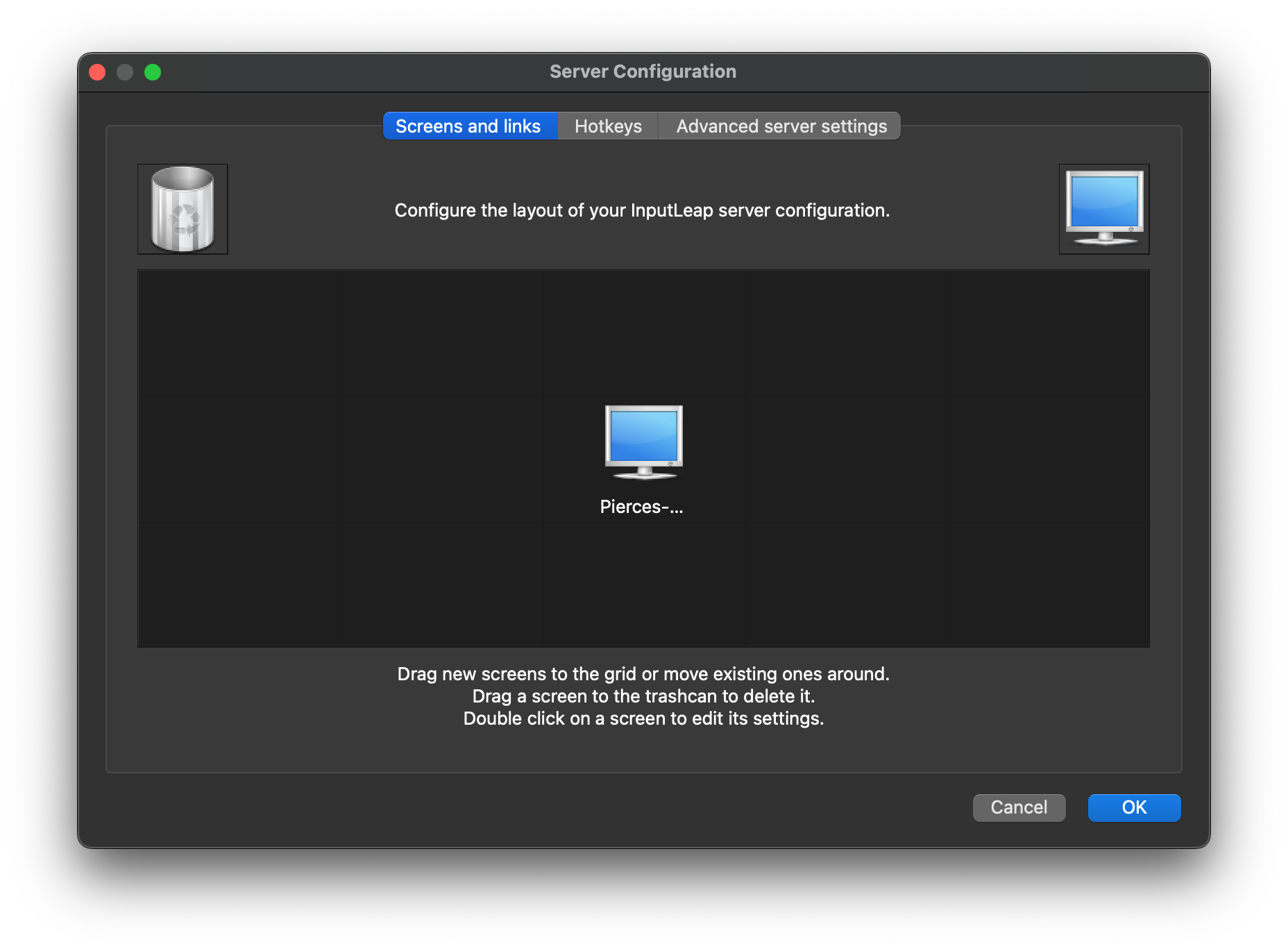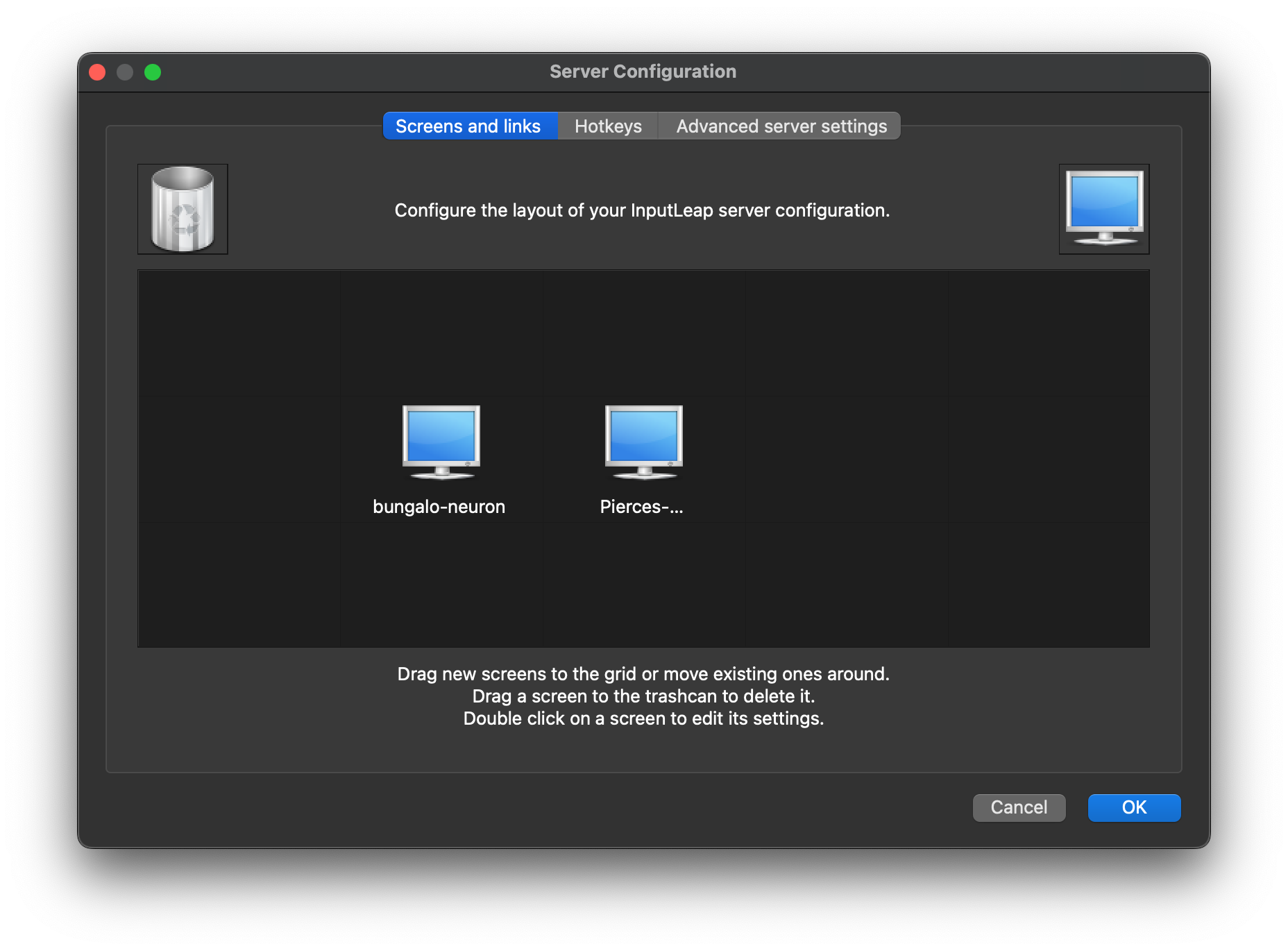Setting up Input Leap
# May 29, 2025
My homelab server is attached to a monitor for dashboard monitoring, but I don't have a dedicated keyboard and mouse permanently connected. This past week Tailscale went on the fritz and I needed physical access. My unideal solution was to dumpster dive through my box of cords until I found a compatible USB-B mouse.
I found input-leap to plug this hole in the future. It's a modern, actively-maintained software-based KVM1. Much like the old physical switches, this lets you share a primary computer's keyboard and mouse with multiple machines over the network.
Alternatives
The KVM software landscape has been pretty bleak for years:
- Synergy: The original open-source solution that InputLeap forked from, but it went commercial and the free version is severely limited
- Barrier: Another Synergy fork that was popular for a while, but development has largely stagnated and it has compatibility issues with modern systems
- Commercial solutions Multiplicity only supports Windows and ShareMouse retails starting at $99
- Hardware KVM switches: Require physical proximity and cable management, defeating the purpose for rack-mounted servers
InputLeap isn't the prettiest solution of the bunch but it's actively maintained, works across platforms (Mac, Windows, Linux), and defaults to SSL. Seems like a good enough bet.
Installing on Mac
Whichever device has your keyboard and mouse physically attached becomes the server. Everything else becomes the client. It's not yet on an official tap so you'll have to add vancluever's formula:
brew tap vancluever/input-leap
brew install input-leap
Installing on Ubuntu
Grab the latest debian release from github.
This seems to only work on Ubuntu 24.02 or newer. I tried on a machine with an older 22 release and it failed at install time.
cd /tmp
wget https://github.com/input-leap/input-leap/releases/download/v3.0.2/InputLeap_3.0.2_debian12_amd64.deb
apt install ./InputLeap_3.0.2_debian12_amd64.deb
Setting up Mac (Phase 1)
Launch the server first:
a. Find the app bundle Homebrew drops it outside the normal /Applications folder:
- Apple-silicon Homebrew:
/opt/homebrew/opt/input-leap/InputLeap.app - Intel Homebrew:
/usr/local/opt/input-leap/InputLeap.app
open $(brew --prefix)/opt/input-leap/InputLeap.app
When you open the app you'll see a configuration dialogue. Select server and walk through the steps. Accept the accessibility and local network devices permissions popup when requested.

Setting up Ubuntu
The main screen looks exactly like the Mac one does. Select client during setup and it should auto-detect the fingerprint of your server's ssl key.
Take note of the "Screen name" portion of the client popup.
Setting up Mac (Phase 2)
Back on the Mac, click on Configure Server. It will pop up this preference pane.

You'll have to configure where you want to drag to access your Ubuntu screen. You'll have to do this manually: drag the screen icon to the position that you want it to transition when you move your mouse towards it. It should be right next to the center window so you can transition directly.
Double click on the computer icon and specify its Screen Name as the same value as you recorded on Ubuntu. When fully configured it should look something like this:

Close this window and click "Reload" on the server panel.
Then get the IP - look for the 192.x.x.x private inet:
ifconfig -a | grep inet
Starting at login
Mac: System Preferences -> General -> "Start at login".
Ubuntu is a bit more complex:
mkdir -p ~/.config/systemd/user
vi ~/.config/systemd/user/input-leap-client.service
[Unit]
Description=Input Leap client
# This will make sure it waits until you actually have a display it can share
After=graphical-session.target
Wants=graphical-session.target
[Service]
# Update with your client screen name and server IP (local LAN grant)
ExecStart=/usr/bin/input-leapc
-f
--name <CLIENT_SCREEN_NAME>
--debug INFO
<SERVER_IP>
Restart=on-failure
[Install]
WantedBy=default.target
Inputleap comes with auto-detection of the server via bonjour when it's running as a GUI but it doesn't have the same functionality via CLI flag.
Load and check status:
systemctl --user daemon-reload
systemctl --user enable --now input-leap-client.service
systemctl --user status input-leap-client.service
journalctl --user -u input-leap-client.service -f
If all is successful you should see:
$ systemctl --user status input-leap-client.service
● input-leap-client.service - Input Leap client
Loaded: loaded (/home/pierce/.config/systemd/user/input-leap-client.service; enabled; preset: enabled)
Active: active (running) since Thu 2025-05-29 09:09:51 PDT; 2s ago
Main PID: 7637 (input-leapc)
Tasks: 3 (limit: 18792)
Memory: 1.9M (peak: 2.4M)
CPU: 37ms
CGroup: /user.slice/user-1000.slice/user@1000.service/app.slice/input-leap-client.service
└─7637 /usr/bin/input-leapc -f --name bungalo-neuron --debug INFO 192.168.1.56
May 29 09:09:51 bungalo-neuron input-leapc[7637]: [2025-05-29T09:09:51] NOTE: connecting to '192.168.1.56': 192.168.1.56:2>
May 29 09:09:51 bungalo-neuron input-leapc[7637]: [2025-05-29T09:09:51] INFO: OpenSSL 3.0.13 30 Jan 2024
May 29 09:09:51 bungalo-neuron input-leapc[7637]: [2025-05-29T09:09:51] INFO: peer ssl certificate info: /CN=InputLeap
May 29 09:09:51 bungalo-neuron input-leapc[7637]: [2025-05-29T09:09:51] NOTE: peer fingerprint (SHA1)
May 29 09:09:51 bungalo-neuron input-leapc[7637]: [2025-05-29T09:09:51] NOTE: fingerprint_db_path: /home/pierce/.conf>
May 29 09:09:51 bungalo-neuron input-leapc[7637]: [2025-05-29T09:09:51] NOTE: Read 1 fingerprints from: /home/pierce/.conf>
May 29 09:09:51 bungalo-neuron input-leapc[7637]: [2025-05-29T09:09:51] NOTE: Fingerprint matches trusted fingerprint
May 29 09:09:51 bungalo-neuron input-leapc[7637]: [2025-05-29T09:09:51] INFO: connected to secure socket
May 29 09:09:51 bungalo-neuron input-leapc[7637]: [2025-05-29T09:09:51] INFO: TLS_AES_256_GCM_SHA384 TLSv1.3 Kx=an>
May 29 09:09:51 bungalo-neuron input-leapc[7637]: connected to server
If the mouse isn't working on the Ubuntu machine but you're seeing logs come through, you're probably running on Wayland which doesn't yet have full support for remote mouse movements.
- Log out.
- On the GDM greeter click the ⚙ gear in the bottom right
- Pick "Ubuntu on Xorg" (Ubuntu remembers the last choice)
- Log back in
- Restart the system daemon:
systemctl --user restart --now input-leap-client.service
-
Only today did I finally learn this stands for keyboard, video, mouse. We love CS acronyms. ↢